Check out our range of stock.
Didn't find what you like?
Send us a message
Found something out of stock?
Send us a message
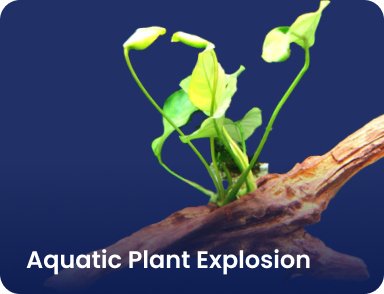

Aquatic Plant Explosion APE is a sustainability project created within the Nano Tanks Australia Brand. It is our hope that with APE we can provide a sustainable, quality products for our customers.
Nano Tanks Australia strives to be an empowering company and the APE Initiative is no different.
In future APE will have it's own YouTube channel and it will be a seperate entity from Nano Tanks Australia. It is the hope that APE will provide essential bunch plants to NTA customers.
Thank you for looking. If there is something you are looking for and it is not present here please let me know and we will try to get it in.
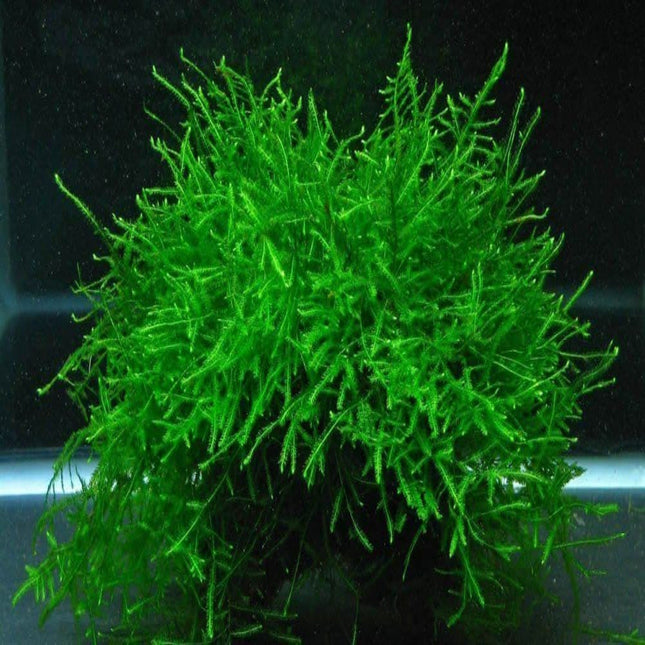
Java moss is one of the easiest to grow, and hardy, aquarium plants around. It belongs to the Hypnaceae family and is native to Southeast Asia. It is very common in moist tropical climates and grows on rocks, river banks and tree trunks. Due to its low requirements regarding water quality and lighting, it is perhaps the most common moss amongst freshwater aquarists and is widely available both in shops and online. It is commonly used for aquascaping and can produce beautiful results. It also has many other benefits such as providing protection for eggs and fry, improving tank health and providing food for breeding fish. Category Rating Care Level: Very easy Growth Rate: Low to Bright Temperature: 15 to 30C (59-86F) PH: 5.0 to 8.0 Reference: https://www.fishkeepingworld.com/java-moss/ Portion Size: 5x5cm when laid out flat which equates to 5 grams weight (without excess water) We send Java Moss orders via Unregistered post
$10.00 $5.00
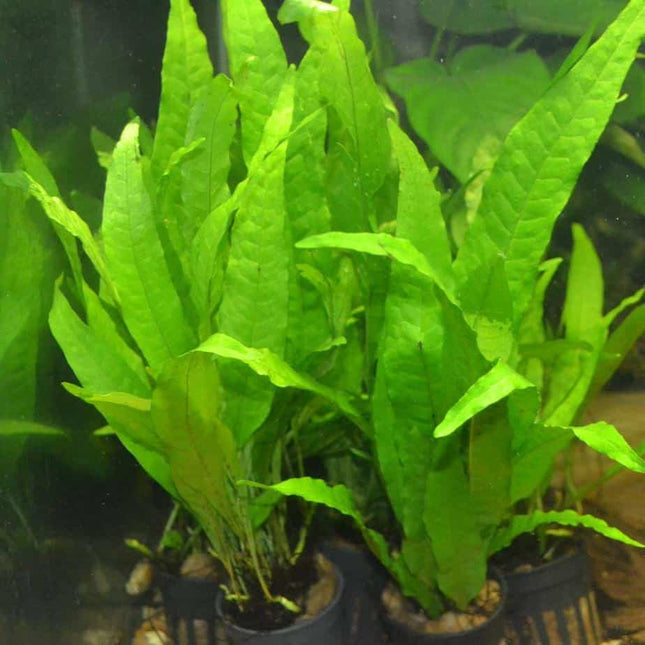
JAVA FERN: THE BEST PLANT FOR YOUR PLANTED AQUARIUM Java ferns (microsorum pteropus) are perfect for aquariums. They're small, easy to grow, and don't need a lot of light to survive. Ask us for varieties we have available. For example, there are needle leaf varieties that require bright lights, as well as more traditional 'jungle' leaves such as the Narrow Leaf, Lance Leaf, and Windelov – their many varieties to suit your needs inside your aquarium. Your fish will appreciate the natural hiding spots provided by Java Fern so they can get away from time to time and feel safe and secure when they want it. Identification If you want a true aquatic plant that can grow when submerged in water or even partially out, then the Java fern is perfect for your tank. Our diverse line of beautiful and delicate-looking Java plants are perfect for people who prefer an aesthetic look inside their home aqua garden without crazy maintenance requirements. When you require a go-to plant that looks great in almost any aquascapes, go with Java Ferns (from Nano Tanks Australia with our aquascaping expertise, of course!). The narrow-leaf Java fern generally boasts long, skinny leaves, with the plant growing to a height of 10-12 inches (25-30 cm). Java Fern is perfect for those who have limited space or are trying to create an artificial jungle feel in their aquarium. The plants need bright light, but indirect (not right under the light), so they can grow properly. Keep in mind the sun has a much more potent energy than your tiny aquarium lights, so aquarium keepers can tend to underestimate the wattage and spectrum required. Saying that, in nature Aquatic Java Fern tends to never receive direct light in the jungle river. So although the Java Fern will be fine with low light in the tank, its growth rate will not impress you. What You Should Know about Java Fern It's probably better than any other plant that would grow inside an aquatic environment for this reason - its fronds are big enough for fish to swim through them without getting stuck between leaves. A striking addition to any freshwater planted aquarium, perfect if you have cichlids or South American fish. Fortunately, it's also relatively easy for plant-eating goldfish and other tank mates to leave it alone because of its tough rhizomes! Java Fern does well in water with pH levels between 6-7.5, as long as the alkalinity stays below eight dKH (aka carbonate hardness). If you see black spots (or brown spots) in your plant's leaves, don't worry - they do that. Java ferns have veins running through them, and sometimes new bumps will pop up on the leaf from which a new shoot emerges. Planting and Replanting Java Fern in the Aquarium Java ferns grow beautifully with other live plants since they are so robust, but they also make a great centrepiece for the aquarium when planted alone. Alternatively, you can attach java fern to aquarium decorations (like rock or driftwood) to create an elegant look that will not overwhelm your fish tank with too much greenery! Java Fern is a hardy plant that can live in any tank size, making it perfect for apartment dwellers who don't have room for large aquariums! If the water stays clean (and you're not adding liquid fertiliser), this resilient Fern's growth will remain consistent without any problems. The Fern prefers water with soft-to-moderate temperatures of 22 degrees Celsius. Data at a glance for Java Fern Family: Polypodiaceae Care Level: Easy Growth Rate: Low to Moderate Maximum Size: 30cm Minimum Tank Size: 20 Litres (tall tank) Water Conditions: 20-28°C pH 6.0-7.5 KH 3-8 Lighting: Low to Moderate (Depending on the desired rate of growth) Propagation: Adventitious Plantlet/Rhizome Division Placement: Mid to Background
$15.00
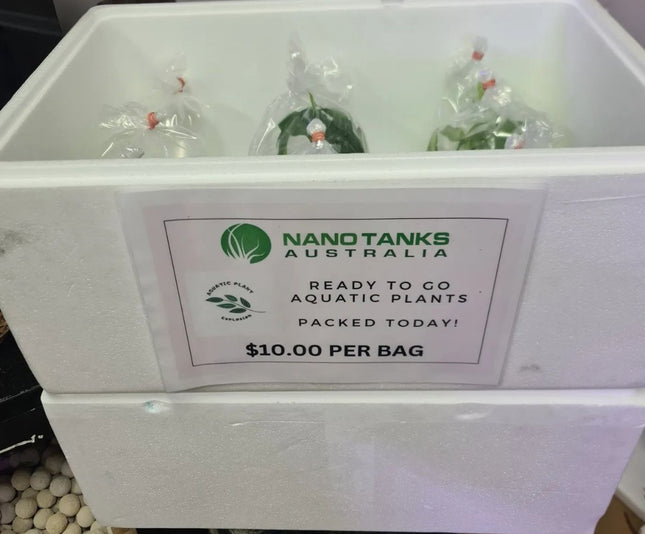
Assorted aquatic plants are a group of plants that are specifically adapted to grow in aquatic environments. These plants can be found in a variety of aquatic ecosystems, including freshwater ponds, streams, rivers, and lakes. Aquatic plants play a crucial role in maintaining the health and balance of aquatic ecosystems by providing oxygen to the water, absorbing excess nutrients, and providing habitat and food for aquatic animals. In the aquarium hobby, aquatic plants are often used to add visual interest and to help maintain good water quality by reducing the amount of harmful nitrogen compounds in the water. Assorted aquatic plants are available in a wide variety of shapes, sizes, and colors. Some of the most common types of aquatic plants include hornwort, Java moss, Anubias, and Cryptocoryne. Each type of plant has its own unique characteristics and requirements for growth, so it's important to research the specific needs of the plants you plan to keep in your aquarium. When keeping assorted aquatic plants in an aquarium, it's important to provide them with the right conditions, including the right type of substrate, adequate light, and the right temperature and water chemistry. In addition, it's important to keep the aquarium well-maintained and to provide regular water changes to ensure that the plants receive the nutrients they need to grow and thrive. Overall, assorted aquatic plants are an important and attractive addition to any aquarium, and they can provide a beautiful and natural underwater environment for your fish and other aquatic animals. Whether you are a seasoned aquarium hobbyist or a beginner, there is sure to be a type of aquatic plant that is right for your aquarium. These plants are packed fresh daily and a great addition for any tank!
$10.00
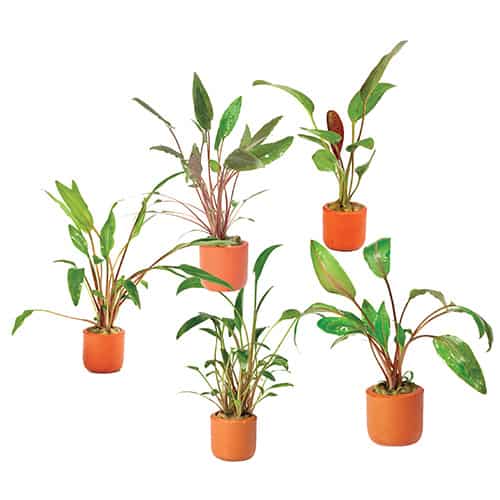
The following are on offer in an assorted basis:Mi OyaLuteaHybridPetchiiWalkeriFamily: AraceaeOrigin: Sri LankapH: 5.5 – 8Temperature: 20 – 30° CHeight: 5 cm – 40 cmLighting: Low
$10.00
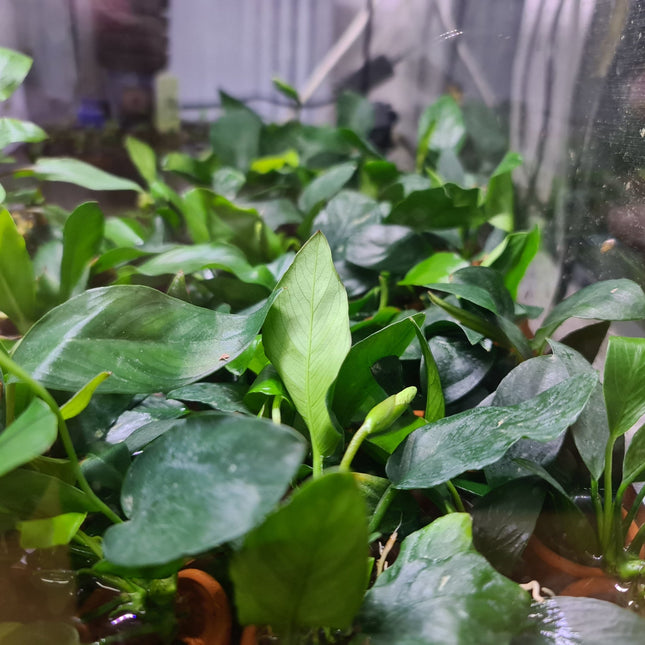
Sold as individual pieces. The image is an example of the quality you are getting Most of what is being sold are: Anubias Barteri Anubias Hastifolia Anubias Nana This is random and there is no choice on which plant you will get unless you are in the shop picking it out yourself
$20.00
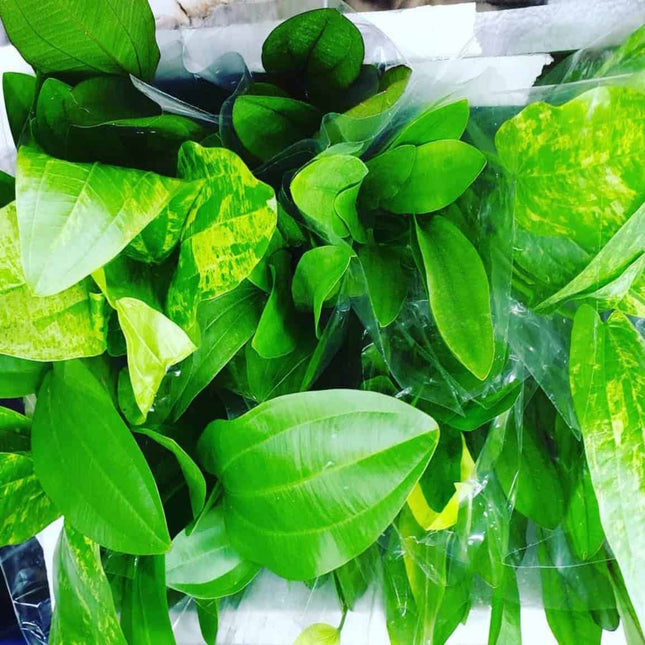
The Amazon Swords or Echinodorus Species are a very nice plant that works well with bright light. These plants are used as a background plant and works well when grown emersed or submersed. If you are looking for an undemanding plant then consider these plants. Minimum Tank Size: 10 Litres Care Level: Easy Water Conditions: 6.5-7.5 (Soft to Moderately Hard) Temperature: 22–27 °C (72–82 °F) Maximum Size: 24 inches (60 cm)
$20.00 - $45.00
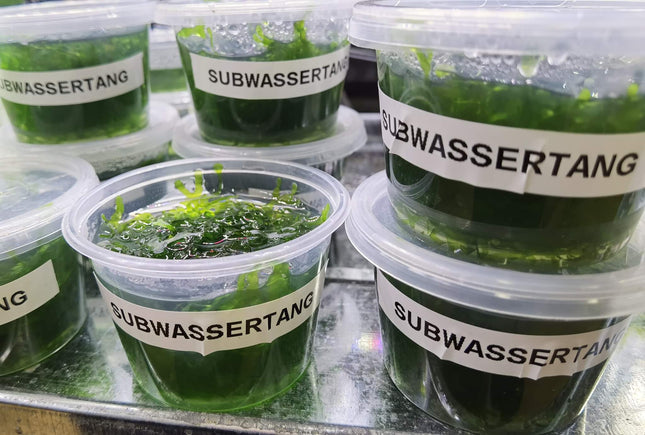
Susswassertang is a type of aquatic plant that is native to Europe and parts of Asia. It is a unique and interesting species that is highly sought after by aquarium hobbyists due to its attractive appearance and ease of care. Susswassertang is a type of liverwort that grows in dense, matted clumps. It has a dark green coloration and a distinctive, textured surface that can resemble a tangled mass of hair or a miniature forest. The plant is non-vascular, which means that it does not have any true roots or leaves, and it absorbs nutrients and gases directly from the water. One of the benefits of Susswassertang is that it is an extremely easy plant to care for. It does not require any special lighting, fertilization, or CO2 supplementation, and it can thrive in a wide range of water conditions. This makes it an ideal plant for beginners or anyone who is looking for a low-maintenance option for their aquarium. Susswassertang is also a versatile plant that can be used in a variety of different aquascapes. It can be attached to rocks, driftwood, or other decorations to create natural-looking features, or it can be allowed to float freely in the water to create a more organic and untamed look. Overall, Susswassertang is an excellent choice for anyone looking for an attractive, easy-to-care-for, and versatile plant for their aquarium. Its unique appearance and hardy nature make it a great option for aquarists of all levels of experience, and its ability to grow in a variety of water conditions makes it a great choice for a wide range of different aquarium setups. What You will be getting You will be getting a 50c portion
$6.00
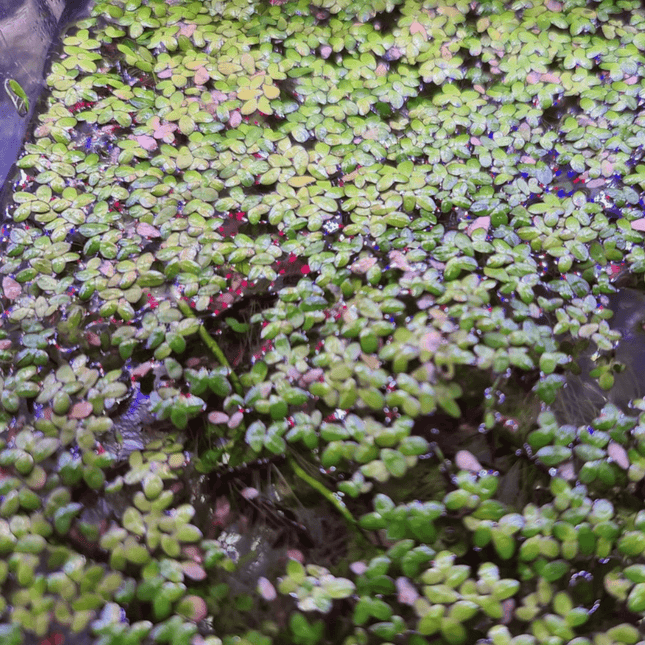
What is Duckweed (Lemna disperma)? Overview Duckweed Lemna disperma is an oval or sometimes round herb that is endemic to Austalia. It has an average size of 1-4 mm long with red and green body coloration that grows 3 to 5 veins. It is known to be one of Earth's most miniature flowering plants. Lemna diaspora tends to form a thick green mat that slowly drifts on the water surface. The plants primarily reproduce vegetatively, with two daughter plants budging off from the adult plant. This type of growth allows new water to be colonized very quickly. Duckweeds sexually multiply themselves by flowering and producing seeds under appropriate water conditions. Duckweeds spread quickly and produce a lot of new offshoots. Therefore, dense populations are beneficial to aquatic species. Herbivore fishes would benefit the most Scientists have recently recognized duckweeds' rapid growth rate, and the plants are now used for bioremediation of waterways with high levels of nitrogen and phosphorus that come from agricultural runoff.
$5.00
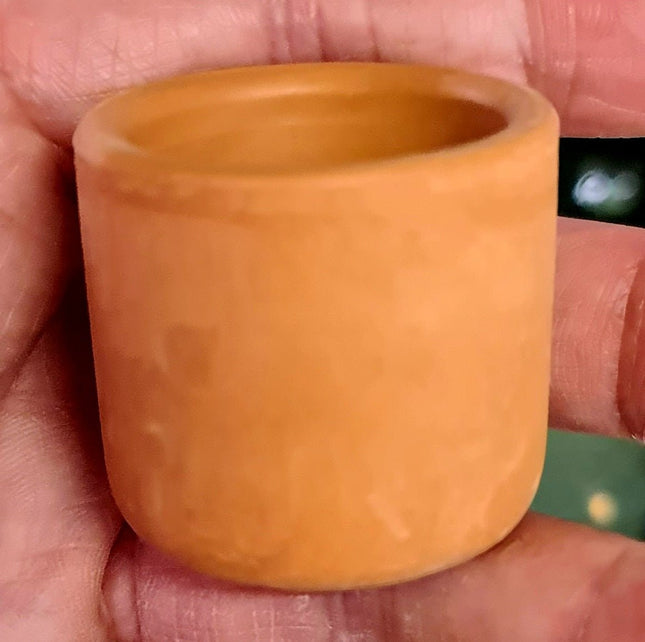
This terracotta pot is 3 cm tall and has a classic, round shape. It is made of terracotta, a type of earthenware clay, and has a light orange hue. The pot is perfect for small plants or succulents, and can easily be used as a decorative piece in any home or garden. The pot is unglazed, making it ideal for plants that require more water, as the clay is porous and allows for better drainage. The terracotta pot is sure to add a rustic charm to any space.
$2.20 - $2.50
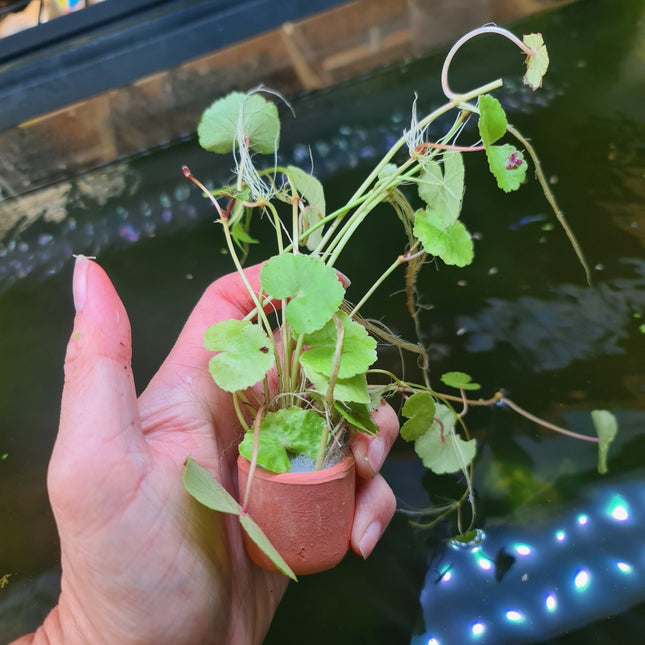
Hydrocotyle Leucocephala originates from the wet marshlands of South America , and also holds the name Brazilian Pennywort. It grows well very well submerged and loves temperatures to be between 18-24C. A fast-growing vine-like aquarium plant with kidney-shaped leaves, Hydrocotyle Leucocephala survives in tanks where other plants fail! It thrives in tanks with or without Co2 added and requires only medium light. In high lights it can become rampant, lower lights make it easier to control. Hydrocotyle Leucocephala looks beautiful intertwined with driftwood. Its delicate leaves are a favourite climbing place for shrimps. Hydrocotyle Leucocephala works particulary well in tanks with Anubias as the two kinds of aquarium plants require similar conditions. Selling in a terracotta pot with 3 to 5 plant let's. These plants should be planted in aqua soil or gravel. Best kept in heights of 30cm tanks We grow this plants in our display tanks.
$10.00
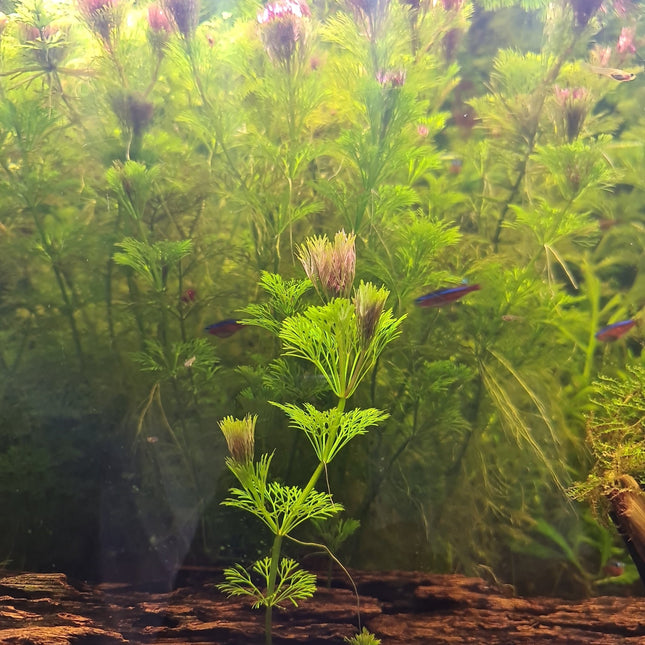
Ambulia is a nice bunched plants that is great for tanks with livebearers or egg scatterers. Ambuilia needs high light to be successful. However when it is established it will grow fast. Please note that the way we sell these are different from other stores. They are best sold loose and best planted loosely.. They are a great source for infusoria and other small invertebrates. Ideally these are floated at the top of the aquarium We grow this in our display tanks Difficulty Easy to keep. Best to keep with species of fish that do not consume plant material. Water Conditions Temperature: 22 - 28°C pH: 5.5 – 8.0 Water Hardness: 70 – 300ppm
$8.00

Banana Lily Nymphoides Aquatica – An Atypical Aquarium Plant for Beginners Nymphoides Aquatica is a lovely aquatic plant that can be used in any pond or planted aquarium. It natively grows along the southeastern United States from Texas to Maryland and has been known various names such as Banana Lily due to its banana-shaped roots. Banana Lily Factsheet Scientific Name: Nymphoides Aquatica Native To South/Southeastern United States Skill Level: Easy Placement: Foreground - Midground CO2 Requirements: none Warning: Banana plants do best if rested on top of the substrate or buried to about 1/4 inch so the plant can send roots down into the substrate. If buried too deeply, the plant may rot and eventually die. Also Snails and plecos are known to eat banana plants! How To Plant Your Banana Plant Introducing a new banana lily to your aquarium is very easy. First, make sure that you have at least two inches of substrate in the tank, such as gravel or sand, and select an area with good lighting conditions and gentle water flow. To keep your plant in place, make sure to rest the plant's tubers on top of the substrate gently. You can also bury them a quarter-inch into the ground if you want it firmly rooted there immediately. Don't worry if none of these methods work for whatever reason, and they still refuse to stay put! They will eventually send down long roots that attach themselves with help from gravity, so this is just something temporary until then - patience is critical when dealing with these plants! At up to 15cm tall, this species can be used for foreground plants, midground planting, or even as background plants for small tanks like 20 litre nano tanks. How To Care For a Banana Lily Banana lilies have a moderate growth rate, and they won't get out of control, making them perfect for beginners and those with limited space. They prefer temperatures between 20 to 28°C and can survive in low-light conditions. (The more light you give it, the faster it'll grow.) These easygoing fellows don't even require CO2. They are hardy little plants! If you want your banana lily to thrive over time, though, be sure to provide an all-in-one liquid fertiliser every three or four months. Not only will this keep their roots healthy but also stimulate cell division within shorter periods so new leaves form much quicker too. At first, the long shoots will grow toward the surface of your tank and start shooting up heart-shaped leaves, which look like lily pads in some cases with small white five petalled flowers. These plants are great for helping filter out excess nutrients from your water while adding an aesthetic beauty that most other aquatic plants can't offer. Just be careful not to let these floating leaves block all of the light from reaching other plants as well - make sure you prune them if needed. There are many ways that the banana lily may perish after planting. One of these possibilities is if its tubers melt away and disappear. There have been a few theories as to why this happens, but no solid explanation. Perhaps the plant doesn't need the lily anymore because it's getting enough nutrients from the roots. Even when plants start looking unhealthy, they can still grow strong with time. How To Grow More Banana Plants Have you ever wondered how to grow banana plants? It's easy! Cut off one of the leaves and let it float around in your tank. Eventually, new roots will appear with some small leaves, which can then be planted back into the substrate. Since banana is in the name, is the Banana Lily at all edible? Banana lily has no known direct food value to wildlife. However, even though it can't be consumed by animals directly, submerged portions of all aquatic plants provide habitats for many micro and macro invertebrates, which are used as food for the animal world. Inevitably when these plants die, their decomposition provides much-needed sustenance that feeds a variety of other underwater denizens. In the home aquarium, the Banana Lily is purely for aesthetics, water quality, and somewhere for smaller fish and shrimp to hide. Variations of Delivery Usually what you get on this picture is what you will receive. Sometimes however you will be getting a leaf. If you do the banana lily will sprout at the base of the leaf
$10.00
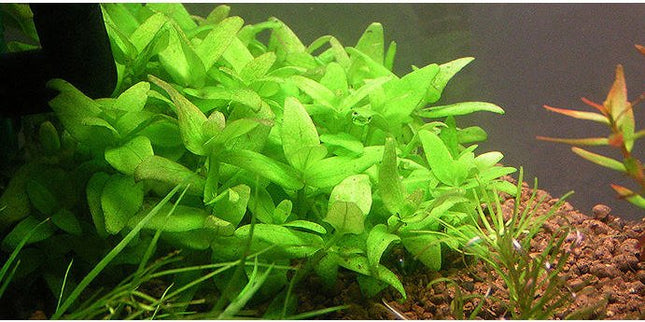
This culture form of the stalk plant Bacopa Monnieri is more compact and, under good light conditions, almost a creeping plant. By pinching off all vertical growing shoots, the plant can maintain a low and close growth, since it willingly creates a large number of side shoots. Furthermore, the plant grows well in the shadow of other plants. Very suitable as a bit higher carpet – or bushy plant in the middle or front of the aquarium. The plant becomes more vertical growing and less compact without CO2 additive and decreased light conditions.
$6.00

Brazilian Pennywort is a great plant for the home aquarium. It can be kept as either rooted or floating, and it will grow up toward light with its leaves shaded underneath in order to provide cover from intruders looking for safe resting spots. Brazilian Pennywort leaves offer a beautiful green colour to your tank. They're different from some other plants, like Water Sprite or Anacharis that may be more typical in an aquarium setting but are still worth keeping if you want something with interesting variety! Brazilian pennywort (Hydrocallis tr subcontracta) is quite unusual among plant life for exactly this reason: its leaf shape sets it apart visually as well as anatomically--you can tell right away just by looking at them whether they come from Brazilians or not; there's nothing else remotely similar out there anywhere nearby either inside our own country borders Aquarium pH: 6.0 – 7.8 Water Temperature: 22 – 30°C Tank Size: Any, but the plant can grow fast and take over quickly Lighting: Wide range, community tank lighting should work fine
$10.00
![[GROWN HERE IN THE STORE] Thin Vallisneria (Vallisneria Torta) - The Elegant, Easy - Growing Background Plant - Nano Tanks Australia](http://nanotanksaustralia.com.au/cdn/shop/files/grown-here-in-the-store-thin-vallisneria-vallisneria-torta-the-elegant-easy-growing-background-plant-1266051.jpg?v=1756827172&width=645)
🌿 Transform your aquarium into a serene, underwater meadow with Thin Vallisneria. This classic, fast-growing plant is the perfect solution for creating a lush, natural background that provides essential shelter for your fish while oxygenating your water. A favorite for beginners and experts alike, Vallisneria is famously low-maintenance. Simply plant it and watch it thrive, quickly spreading to fill your tank with vibrant, ribbon-like greenery. HIGHLIGHTS: Rapid Growth: Establishes quickly and spreads via runners for a full, natural look. Easy Care: Thrives in a wide range of water conditions with minimal effort. Natural Filtration: Helps absorb excess nutrients, reducing algae and improving water quality. Provides Shelter: Creates a safe haven for shy fish, shrimp, and fry. PRODUCT DETAILS: Common Name: Thin Vallisneria Scientific Name: Vallisneria Torta Origin: Southeast Asia Growth Rate: Fast Light Requirement: Low to Moderate Care Difficulty: Easy Placement: Background Propagation: Spreads by sending out runners (stolons) WHAT YOU GET: You will receive one (1) loose bunch of Thin Vallisneria, containing 5+ healthy individual stems with established roots. Please note: As a live plant, some melt may occur while it adapts to your aquarium. This is normal, and new growth will quickly follow. We want to make sure that what we sell will root well and therefore please note that the size of your plants want be that big. FAQ & PLANTING TIPS How do I plant Thin Vallisneria?Gently separate the stems. Using planting tweezers, plant each individual stem into your substrate (gravel or sand works fine), ensuring the crown (where the leaves meet the roots) is just above the substrate. Space them a few inches apart to allow runners to spread. Will it grow in my low-tech tank?Absolutely! Thin Vallisneria is an excellent choice for low-tech setups without CO2 injection. It will benefit from root tabs or liquid fertilizers but can often grow well without them. How tall does it get?It typically reaches heights of 10-20 inches, making it ideal for the mid-to-background of most aquariums. It will grow to fit the height of your tank. Why are the leaves twisted?The slightly twisted, corkscrew-like form of the leaves is a natural characteristic of the Vallisneria Torta species, giving it more texture and visual interest than straight Vallisneria varieties. 🏡 CREATE THE AQUASCAPE OF YOUR DREAMS!Pair Thin Vallisneria with driftwood, rocks, and other easy plants like Anubias or Java Fern for a stunning, natural-looking ecosystem. Your fish will thank you for the beautiful and functional home! 🔒 LIVE ARRIVAL GUARANTEED: We take extra care in packaging our plants to ensure they arrive healthy and vibrant. Please refer to our policy page for details. Add Thin Vallisneria to your cart and start your underwater garden today! Please note that pond snails and algae maybe present
$10.00
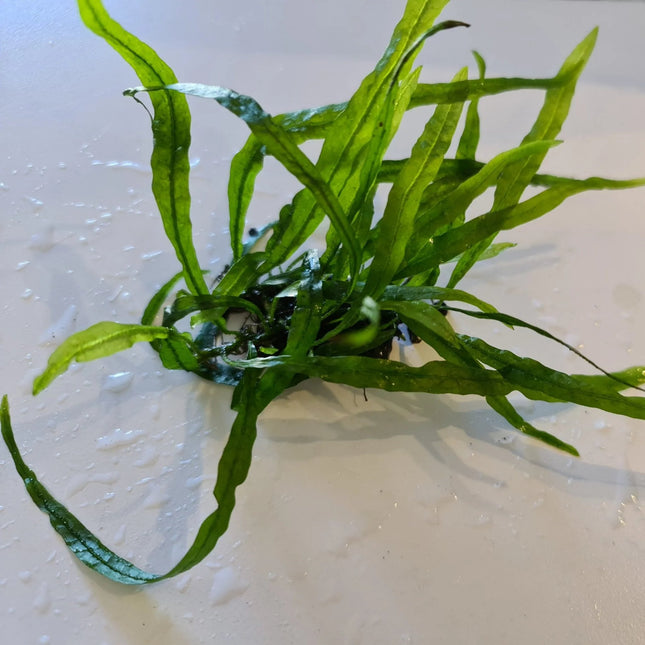
Needle-Leaf Java Fern Loose is a type of fern that is native to tropical climates, including parts of India and Southeast Asia. It features thin, needle-like leaves that are bright green in color and grow in a loose, spreading pattern. It prefers low to medium lighting conditions and is an easy-care plant, making it a great choice for beginners. It is a slow-growing plant and can be propagated by division or by removing the rhizomes and replanting them in fresh substrate. It is an ideal plant for adding texture and color to aquariums, terrariums, or vivariums.
$20.00
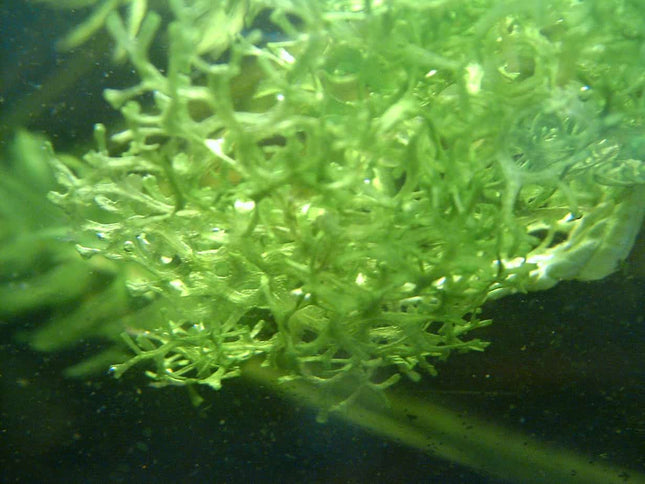
Riccia fluitans, whose common name is floating crystalwort, is an aquatic floating plant of the liverwort genus Riccia which is popular among aquarists as a retreat for young fry and is used in live-bearing tanks. It can be found floating in ponds, and often forms thick mats on and under the water surface. It normally grows quickly at the surface. When kept about two to three inches below an ordinary fluorescent bulb or in a pond exposed to full sunlight, it will form dense, bright green mats. Any single branch or antler bud can reproduce into a large colony if the plant is kept in proper conditions. It normally floats, but can also be attached to underwater objects such as logs and rocks. It can be attached with plastic mesh. Floating crystalwort is generally not compatible with duckweeds, as they cover the surface of the water quite rapidly, crowding the Riccia out. It is also easily overtaken by hair algae. Source: Wikipedia contributors. (2019, June 5). Riccia fluitans. In Wikipedia, The Free Encyclopedia. Retrieved 05:38, October 19, 2019, from https://en.wikipedia.org/w/index.php?title=Riccia_fluitans&oldid=900409775
$9.95

Also known as Ceratopteris thalictroides "Fein" Fine-leaved Fast growing Not demanding Also suitable as floating plant Ceratopteris thalictroides is an amphibic fern found in many tropical regions of the world in shallow waters and on muddy ground, amongst others in rice paddies. In some tropical regions of Asia the emersed leaves of this species are used as vegetable. In nature, this plant is said to be an annual plant, however, it can be cultivated over several years without problems. The species contains many local forms, and in aquaristics, varietys with more coarsely or finely pinnate submersed leaves are common (photos 1 to 3 show an especially delicate form of C. thalictroides). The species has been known in the hobby for many years, also under the synonym of Ceratopteris siliquosa as well as under the vernacular names of water sprite, Indian fern, Oriental waterfern and water hornfern.Botanists disagree whether Ceratopteris cornuta, originating from Africa, is to be considered a species of its own or a synonym of C. thalictroides. In aquaristics, those plants with coarser lobes/leaflets are generally called C. cornuta, and those with finer leaflets are known as C. thalictroides. It is not clear, however, if those coarser-looking plants are truly C. cornuta or simply a variety of C. thalictroides (in the narrower sense). A third species, Ceratopteris richardii, can only be discerned from C. thalictroides and C. cornuta by the number of spores per sporangium. Moreover, Ceratopteris species are known to hybridise.C. thalictroides is a very fast growing fern and is usually cultivated free-floating on the water surface, like all other Ceratopteris species. Labyrinth fish gladly accept it for building their bubble nests, and it provides fish fry with great places to hide. However, when planted into the ground it grows even better as a submersed plant. C. thalictroides forms large, fine-leaved, light green bushes within a short time, and as it requires a lot of space it is best cultivated in large tanks as solitary plant. Its requirements are not difficult to meet; medium light intensities and CO2 concentrations of under 20 mg/l are sufficient, however, the fern will grow better under intensive light, with additional CO2 and nutrient-rich water.It forms plantlets in the grooves between the lobes of older leaves, like other Ceratopteris species, however, in lower numbers. In order to further the development of these plantlets it is recommended to sever the older leaves from the plant and let them float on the surface.In shallow water and on wet substrates rich in nutrients, C. thalictroides forms emersed leaves, which are finely pinnate, too. Spore-carrying fronds have very narrow leaf tips. Their margins are rolled in towards the underside and thus cover the sporangia (spore capsules). Synonyms Acrostichum thalictroides L., Ceratopteris froesii Brade, Ceratopteris gaudichaudii Brongn., Ceratopteris siliquosa (L.) Copel. Complete botanical name Ceratópteris thalictroídes (L.) Brongn. Family Pteridaceae Genus Ceratopteris Difficulty easy Usage Background, Plant for spawning, Midground, Specimen plant, Water surface Growth very fast pH value 5 - 8 Temperature tolerance 18 - 30°C Carbonate hardness 0 - 21°dKH General hardness 0 - 30°dGH Propagation Proliferating leaves, Spores Can grow emersed? yes Source: flowgrow
$10.00

This miniature version of the well-known Alternanthera is characterised by compact growth and a slower growth rate. It is particularly suitable for small aquariums or as a foreground plant in larger aqua scapes. By careful trimming can you create a dense, red-violet carpet approximately 5 to 10 cm high. High light intensity and addition of CO2 improves the plants growth and overall appearance. Plant information Type: Stem Origin: Cultivar Growth rate: Medium Height: 5 - 10+ Light demand: Medium CO2 : Medium Reference: https://tropica.com/en/plants/plantdetails/Alternantherareineckii'Mini'(023CTC)/4439 Please note that Pisces has omitted the 'mini' label in their recent labels. However we are assured these are still the mini variety This is for 5 stems around 10cm long
$10.00
![[ALWAYS IN STOCK] Guppy Grass aka Pearlweed (Najas guadalupensis) - The Versatile Aquarium Carpet Plant - Nano Tanks Australia](http://nanotanksaustralia.com.au/cdn/shop/files/always-in-stock-guppy-grass-aka-pearlweed-najas-guadalupensis-the-versatile-aquarium-carpet-plant-5845063.jpg?v=1759763041&width=645)
The Ultimate Versatile Plant for Any Aquarium! PORTION SIZE: 5 Stems approx 10cm each. Great to start your tank in. Short Description:Discover Pearlweed - the incredibly adaptable aquarium plant that does it all! Whether you want a lush carpet, a dense bush, or floating surface cover, this fast-growing plant delivers stunning bright green results. Perfect for beginners and aquascaping pros alike. Key Features & Highlights 🌱 INCREDIBLY VERSATILE: Use as carpeting plant, bushy midground, or floating surface cover - adapts to any placement 💨 FAST GROWTH: Quickly fills in empty spaces and helps control algae by consuming excess nutrients 💪 EASY & LOW LIGHT: Thrives in low to moderate light without CO2 injection - perfect for beginner plant keepers 🦐 SHRIMP & FRY PARADISE: Dense growth provides perfect hiding spots and grazing surfaces for shrimp and baby fish ✂️ EASY PROPAGATION: Simply trim and replant stems to quickly multiply your plant collection Detailed Description Meet Pearlweed, the unsung hero of the aquarium plant world! This North American native has earned its place in aquariums worldwide thanks to its remarkable adaptability and vigorous growth. Whether you're creating your first planted tank or designing an elaborate aquascape, Pearlweed delivers stunning results with minimal effort. What makes Pearlweed truly special is its chameleon-like ability to adapt to how you plant it. When regularly trimmed, it forms a dense, bright green carpet that rivals more demanding plants. Left to grow taller, it creates beautiful bushy clumps perfect for midground placement. And when left floating, it provides valuable surface cover for shy fish and breeding tanks. This plant is particularly valuable for new aquarists, as its fast growth provides immediate satisfaction and helps establish tank balance. For experienced hobbyists, it's an essential tool for filling spaces and creating natural-looking aquascapes without the high maintenance requirements of more delicate species. Perfect For: Beginner planted tanks Carpeting experiments Shrimp and fry tanks Fast-filling new setups Low-tech aquariums Breeding tanks Specifications & Care Guide Parameter Requirement Scientific Name Najas guadalupensis Common Names Pearlweed, Guppy Grass Lighting Low to High CO2 Requirement Not Required (Benefits from supplementation) Growth Rate Very Fast Difficulty Level Easy Placement Foreground, Midground, or Floating Temperature 68°F - 82°F (20°C - 28°C) Propagation Stem cuttings Planting & Maintenance Planting Methods: Carpeting: Plant small stems close together and trim regularly Bushing: Group several stems together and allow to grow upward Floating: Simply drop stems in water - they'll naturally float and grow Maintenance: Trim weekly to maintain desired shape Replant trimmings to fill bare spots Thrives with regular liquid fertilizers Can grow 1-2 inches per week in optimal conditions Benefits: Rapidly improves water quality Provides oxygen through photosynthesis Reduces algae competition Creates natural habitat for aquatic life Important Considerations ⚠️ FAST GROWTH: Requires regular trimming to prevent overgrowth 🚫 CAN BECOME INVASIVE: Dispose of trimmings carefully, don't release into local waterways 🌿 VERSATILE BUT MESSY: Floating growth can appear unkempt if not maintained 🐠 EXCELLENT COVER: Ideal for breeding tanks and shy species 💡 ADAPTS TO LIGHT: Growth pattern changes based on light intensity 🔄 EASY TO CONTROL: Simple to remove or thin out if it grows too vigorously Healthy Plant Guarantee Our Pearlweed is grown in optimal conditions and shipped with careful packaging to ensure it arrives fresh and healthy. Each portion is pest-free and ready to plant upon arrival. Ready to transform your aquarium with this versatile plant? Add Pearlweed to your cart today!
$6.00
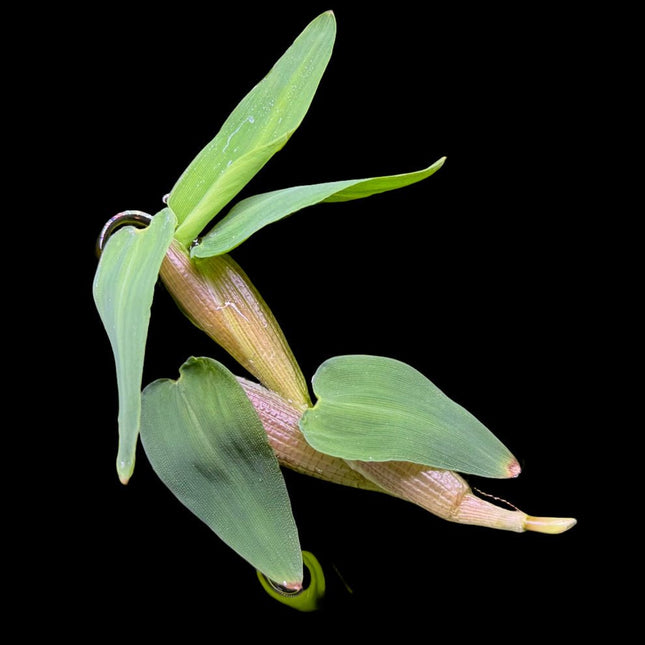
Hygroryza aristata is a unique floating aquatic plant in the Poaceae family. This species is known for its attractive appearance and ability to create a lush, green canopy on the water's surface. Its floating nature and distinctive foliage make it a fascinating addition to any aquarium, providing both aesthetic appeal and functional benefits such as shading and habitat for aquatic life. Key Features: Scientific Name: Hygroryza aristata Common Name: None Family Name: Poaceae Water Parameters: Temperature: 22°C - 28°C pH: 6.0 - 7.5 Hardness: Soft to moderately hard water Light Requirement: Moderate to high lighting Bright light promotes vigorous growth CO2 Requirements: Not necessary Can thrive without CO2 supplementation Plant Appearance: Leaves: Narrow, elongated leaves that float on the water surface, forming dense mats. Growth Habit: Floating stems that spread across the water, providing cover and reducing algae growth by blocking light. Size: Can cover large areas of the water surface, suitable for tanks of various sizes. Care Tips: Regular trimming helps manage its spread and keeps the plant from overcrowding the tank. Thrives in nutrient-rich water, benefiting from regular fertilization. Ideal for providing shade and creating hiding spots for fish and invertebrates. Hygroryza aristata is an exceptional choice for aquarists seeking to add a unique, floating plant to their aquariums. Its ease of care and ecological benefits make it a valuable addition to any aquatic environment. Please note that depending on the season the look of this plant will vary
$8.00
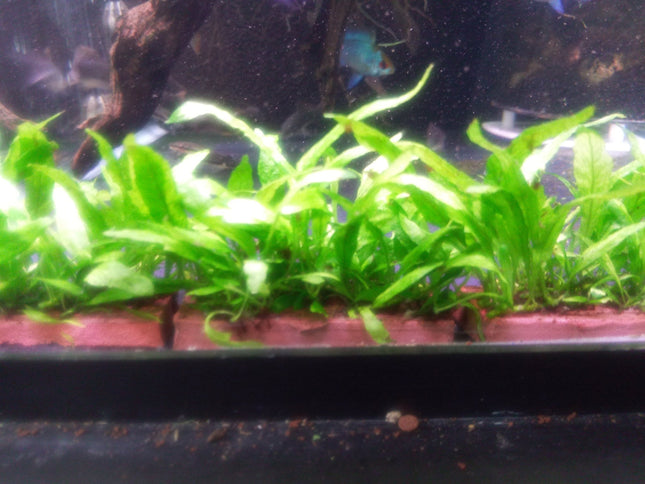
Java-fern-mini is a small, low-maintenance aquatic plant with delicate, bright green leaves. It is a popular choice for aquascaping and aquarists alike due to its low-maintenance nature and its ability to thrive in low-light conditions. It is easy to propagate and can be grown both submerged and emerged, making it a versatile plant for aquariums of all sizes. Its leaves provide a natural filter for the water, removing toxins and pollutants, and its roots help to keep the aquarium substrate clean. This came in a small terracotta pot. It will stay smallish.
$15.00

Windelov Java fern, also known as Microsorum pteropus 'Windelov', is a popular aquatic plant among aquarists due to its ease of care and unique appearance. Its leaves are characterized by small, narrow lobes that create a delicate, lacy effect. Windelov Java fern can be attached to rocks, driftwood, or other aquarium decor, making it a versatile option for aquascaping. It is also known to be hardy and tolerant of a range of water conditions. In addition to its use in aquariums, Windelov Java fern can also be used in terrariums to add a touch of greenery. PLEASE NOTE THAT THIS COMES IN A CLAY POT NOT A PLASTIC POT AS PER THE PICTURE
$19.00

Dwarf Baby Tears (Hemianthus callitrichoides) is a semi-aquatic plant in the Linderniaceae family. It is also known as Water Starwort, and it can be found in the West Indies, including Cuba, Puerto Rico, and The Bahamas. This plant was first collected by Holger Windeløv and Eusebio Canicio Delgado Pérez in 2003 in Las Pozas, Cuba. With its lush green cluster of leaves; sometimes they are mistaken for Monte Carlo when looking at pictures alone. Dwarf Baby Tears Care Dwarf baby tears must be pruned regularly. This is helpful when living in an aquarium with other fish, as dwarf baby tears are typically able to recover from being nipped at. It's best to avoid goldfish, cichlids, or really any larger fish, to help keep a calming environment for your dwarf baby tears. The carpet of green made by the DWARF BABY TEARS cluster leaves provides a great place for aquatic life to leave eggs and start breeding other aquatic life. Dwarf Baby Tears Lighting Aquarium lighting is very important when you consider preparing for dwarf baby tears. You want to make sure not to go above 25° C as higher temperatures have been reported to kill the plants by “melting” or turning the leaves brown. The optimal pH level is anywhere between 6.0-7.5.5. Dwarf baby tears really won’t thrive without light, and lots of it, and a good rule of thumb would be to get yourself a digital thermometer and regularly check the temperature Dwarf Baby Tears CO2 The dwarf baby tears growth process can typically be slow, however, once the bright green leaves blossom they will spread horizontally along the base of your tank, as well as vertically. If you choose to go the CO2 route, which I recommend you do, you may also choose to use an injection of CO2 10-30 mg/l. A nano tank is really the best option, provided that you are able to keep it well-lit and temperature regulated. To have the best success rate, a high-tech tank is the best way to go. Dwarf Baby Tears Carpet Dwarf baby tears will grow throughout your aquarium tank, allowing for other fish to graze and hide their eggs. The importance of high light content and CO2 requirements allows for each portion of the plant to populate and produce stems that can then branch off and begin to grow alongside the aquarium. Is it possible to successfully grow dwarf baby tears on any surface, such as rocks, driftwood, and gravel, but which is the best route to take? It seems to be a matter of preference for most people as any of these will wield the results of carpeting. Growing Dwarf Baby Tears on Driftwood and Rock Driftwood is commonly used with dwarf baby tears, as it can be fairly easy to grow around. Having cracks in the driftwood is also beneficial as it gives the clusters more room to grow and immerse itself within the wood. Some people also chose to use sand as opposed to rocks or gravel, as this is believed to help the roots grow easier and faster. If you start to notice a brown coloring to your green clusters, this is a sign that the leaves are starting to die off. Pruning Dwarf Baby Tears Dwarf baby tears tend to be iron deficient, so they would best thrive off a nutrient rich substrate. Aqua Soil Powder is a great option to use as it is rich in nutrients and minerals that promote healthy growth, while also appearing in a natural earth coloring that looks visually stunning in any aquascape. Dwarf Baby Tears tend to grow into a large carpet at the bottom of your tank. If you start to notice yellowing on your leaves, this is a sign of an iron deficiency and it’s best to act fast and dose it with iron supplements.
$8.00

As a species of fern, Ceratopteris cornuta is a great choice for beginners as it is low maintenance and easy to grow. With its characteristic layered and feathery leaves, it adds a beautiful natural touch to any aquarium. This plant can also help oxygenate the water and absorb excess nutrients, promoting a healthier aquatic environment.
$14.00

Alternanthera Bettzickiana is a popular choice for beginners due to the fact that it's pretty easy to grow. Most red stem plants can prove difficult to get that vibrant red color without providing high CO2 and micronutrients. This plant will keep its vibrant red and pink hues with relative ease, but if nutrients and lighting are severely lacking, the leaves can dull out to an orange hue. It prefers high nitrates and high phosphates so dosing fertilizers such as UNS Plant Food will help speed up growth and keep coloration at its best. A nutrient-rich substrate is necessary when growing this plant. Notes: Alternanthera provides great coverage for sensitive species and are relatively easier choices for beginners who are looking for colored aquarium plants. Do not make drastic changes to the aquarium. Unstable parameters will result in melt and rotting of the aquarium plant. Please be sure to remove this plant from its pot. Remove the cotton surrounding the roots and plant into a quality substrate. For instructions on how to properly prep "potted" aquarium plants, click here. CO2 injection and quality aquarium soil will yield better growth. Please research appropriately to ensure your plant thrives. Family Name: Amaranthaceae Origin: Central/South America Height: 4-12” pH: 6.5-7.5 Care: Easy to Moderate Light: Medium to High Co2: Required Propagation: Cut stem and replant Growth rate: Moderate to Fast
$10.00
![[ARRIVED 5 - JUN - 2025] Bacopa caroliniana 5 stems 10cm tall - Nano Tanks Australia](http://nanotanksaustralia.com.au/cdn/shop/files/arrived-5-jun-2025-bacopa-caroliniana-5-stems-10cm-tall-466097.png?v=1749114201&width=645)
Bacopa Caroliniana – The Hardy & Beginner-Friendly Stem Plant Origin: Native to the United States.Size: Stems grow 10–30 cm long with leaves 3–4 cm wide.Growth Habit: Branches readily from the base, forming lush, bushy clusters. Why Choose Bacopa Caroliniana? ✔ Low Maintenance – Perfect for beginners! Thrives with minimal care.✔ Slow Growth – Unlike fast-growing stems, it won’t overcrowd your tank quickly.✔ Easy Propagation – Simply trim a side shoot and replant into the substrate. Aquascaping Tips 🌿 Plant in small groups for a natural, decorative effect.🌿 Ideal for midground/background in nano or larger tanks.🌿 Versatile – Adapts to a range of lighting and water conditions. A timeless favorite for effortless beauty in planted aquariums!
$10.00 $6.00

Syngonium is a genus of tropical and subtropical plants that are popular in the aquarium hobby. The most commonly used species in aquariums is Syngonium podophyllum, which is also known as the Arrowhead plant. In an aquarium, Syngonium plants are typically used for their aesthetic appeal and their ability to absorb excess nutrients from the water, which can help to improve water quality. Syngonium plants are a type of epiphytic plant, which means that they can grow without being rooted in soil. Instead, they can attach themselves to rocks, driftwood, or other decorations in the aquarium. Syngonium plants have heart-shaped leaves that can vary in color, from green to variegated shades of green and white. One of the benefits of using Syngonium plants in an aquarium is their ability to absorb excess nutrients from the water. This can help to reduce the levels of nitrates and phosphates, which can be harmful to fish and other aquatic inhabitants if they are present in high levels. Additionally, Syngonium plants can help to improve water clarity by absorbing particulate matter from the water. Syngonium plants are also popular in aquascaping because of their aesthetic appeal. They can be used to create a natural-looking environment in the aquarium and can add a pop of color to an otherwise dull aquascape. Syngonium plants can be used as a foreground or midground plant, and can be grown both emersed (with their leaves above the water) and submersed (with their leaves below the water). In terms of care, Syngonium plants are relatively easy to grow and require moderate lighting and regular fertilization. They can be propagated by taking stem cuttings and rooting them in the substrate or by attaching them to decorations in the aquarium. Overall, Syngonium plants are a versatile and attractive addition to any aquarium, and can provide both aesthetic and functional benefits.
$14.95
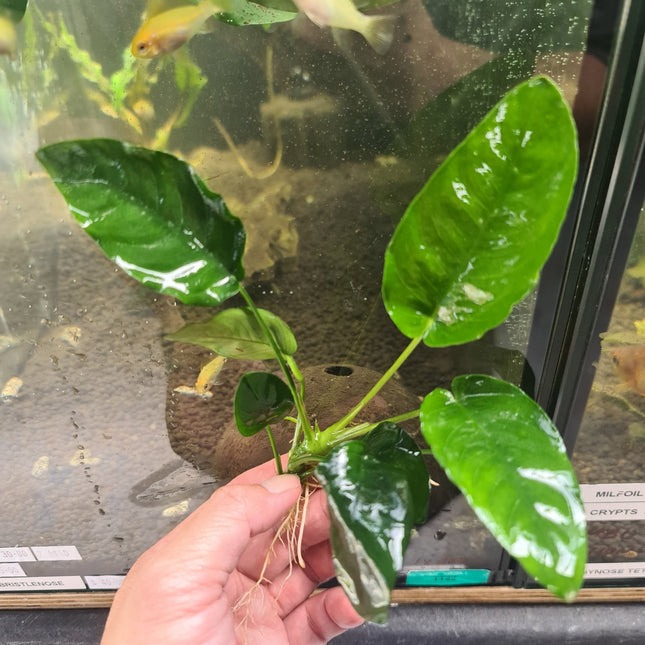
Sold as individual pieces in a terracotta pot The image is an example of the quality you are getting
$25.00
![[ARRIVED 20 - JUN - 2025] Echinodorus Martii bareroot - Nano Tanks Australia](http://nanotanksaustralia.com.au/cdn/shop/files/arrived-20-jun-2025-echinodorus-martii-bareroot-782598.jpg?v=1750749841&width=645)
Description:Echinodorus Martii, commonly known as the Ruffle Sword Plant, is a striking aquatic species prized for its long, wavy-edged leaves that create a dramatic, textured appearance in aquariums. Its bright green, ruffled foliage adds visual interest and serves as an excellent midground to background plant, particularly in larger tanks where it can grow up to 12–24 inches (30–60 cm) tall 147. Key Features: Leaf Structure: Long, thick leaves with ruffled margins and light striations, providing a lush, natural look 14. Growth Habit: Forms a rosette and can produce adventitious shoots (side runners) for propagation 15. Color & Contrast: Its vibrant green hue pairs well with red plants, enhancing aquascape aesthetics 18. Care Requirements: Lighting: Thrives in moderate to high light but adapts to lower light with slower growth 17. Substrate: Requires a nutrient-rich substrate (e.g., enriched soil or root tabs) as it is a heavy root feeder 1411. CO2 & Fertilization: CO2 is optional but boosts growth; benefits from iron and trace elements 47. Water Parameters: Prefers 72–84°F (22–30°C), pH 5.0–7.5, and soft to moderately hard water 711. Propagation & Maintenance: Propagates via side shoots or rhizome division 47. Prune older leaves to control size and encourage new growth 15. Ideal For: Beginners due to its hardiness 13. Centerpiece or background in mid-to-large tanks 28. Origin: Native to Central and South America, often found in submerged riverbanks 15. Note: Some taxonomists classify E. martii as synonymous with E. major or E. subalatus, but it remains a trade staple under its common name 5.
$20.00

$15.00

“Araguaia” is a river system in Brazil and it is under this name that the plant has become known. There are many signs, however, that the plant is a Hygrophila lancea from Japan and Hong Kong. The stem becomes 10-20 cm tall and 6-15 cm wide. It has compact, tight-sitting leaves and grows branches easily. Pinching of the stems maintains a bushy look. The colour is reddish brown to purple, promoted by good growth conditions. The growth rate is average for a Hygrophila. Plant info Type: Stem Origin: Asia Growth rate: Medium Height: 10 - 20+ Light demand: Medium CO2 : Medium
$10.00
![[ALWAYS IN STOCK] Bacopa Sessiliflora japan - The Versatile Mid - Ground Stunner (5 stems 10cm) - Nano Tanks Australia](http://nanotanksaustralia.com.au/cdn/shop/files/always-in-stock-bacopa-sessiliflora-japan-the-versatile-mid-ground-stunner-5-stems-10cm-8784298.jpg?v=1761413609&width=645)
Vibrant, Versatile, and Incredibly Easy: Bacopa Sessiliflora 'Japan' Short Description:Discover Bacopa Sessiliflora 'Japan' – the perfect stem plant for aquarists of all levels! Known for its bright green color, robust upright growth, and remarkable adaptability, this plant adds lush, vibrant structure to any part of your aquarium. Whether you're a beginner or a seasoned aquascaper, it delivers stunning results with minimal effort. Key Features & Highlights 🌿 VIBRANT LIGHT GREEN COLOR: Bright, refreshing green leaves that create a beautiful contrast against darker hardscape and red plants. 💪 INCREDIBLY EASY & LOW TECH: Thrives in low to medium light without CO2 injection, making it perfect for low-tech and beginner tanks. 🔼 UPRIGHT & COMPACT GROWTH: Grows vertically with a sturdy stem, making it ideal for creating structured bushes in the mid-ground or background. 🚀 FAST-GROWING & ALGAE-RESISTANT: Rapid growth helps outcompete algae and quickly fills in your aquascape. ✂️ EASY TO TRIM & PROPAGATE: Simply cut the stem and replant the tops to create new plants and maintain a dense, bushy appearance. Detailed Description Bring a touch of vibrant, structured beauty to your aquarium with Bacopa Sessiliflora 'Japan'. This versatile stem plant is a favorite among aquascapers for its reliability and eye-catching color. Its strong upright growth habit allows it to stand out as a distinctive mid-ground bush or a lush background curtain, bringing depth and dimension to your layout. Unlike more demanding stem plants, Bacopa Sessiliflora 'Japan' is wonderfully low-maintenance. It adapts well to a variety of conditions, from low-tech setups to high-tech planted tanks. Its fast growth rate not only gives you quick satisfaction but also helps maintain water quality by absorbing excess nutrients that would otherwise feed algae. Perfect For: Beginner planted tanks Low-tech and high-tech aquariums Mid-ground or background grouping Nature aquariums and Dutch-style scapes Providing shelter for shrimp and small fish Specifications & Care Guide Parameter Requirement Scientific Name Bacopa sessiliflora Common Names Bacopa Japan, Japanese Bacopa Lighting Low to High CO2 Requirement Not required (beneficial in high-tech tanks) Growth Rate Fast Difficulty Level Easy Placement Mid-ground, Background Temperature 68°F - 82°F (20°C - 28°C) Propagation Stem Cuttings Planting & Maintenance Tips How to Plant: Separate stems and plant individually in the substrate. Space stems about 1-2 inches apart for a bushy effect. Can be planted in groups for an instant filled-in look. Maintenance: Trim regularly from the top to encourage bushy side growth. Replant trimmings to expand your group or create new ones. Benefits from liquid fertilizers for more vibrant growth. Growth Tips: In high light, growth may become more compact and dense. If leaves appear pale, consider supplementing with iron and micronutrients. Important Considerations ⚠️ FAST GROWTH: Regular trimming is needed to prevent it from overshadowing other plants. 🚫 MINIMAL PEST RISK: Grown in our aquatic farm, so it’s free from pests and algae. 🌿 VERSATILE USES: Perfect for creating "plant streets" in nature aquariums or structured groups in Dutch layouts. 💡 LIGHT ADAPTATION: Color and leaf size may vary slightly based on light intensity and nutrient availability. Healthy Plant Guarantee Our Bacopa Sessiliflora 'Japan' is grown submersed in optimal conditions, ensuring it is healthy, pest-free, and ready to grow in your aquarium. We guarantee it will arrive in healthy condition or we’ll make it right. Add vibrant, easy-care structure to your aquascape. Order Bacopa Sessiliflora 'Japan' today!
$10.00

Ludwigia Atlantis is a rare and vibrant mutation of Ludwigia Repens, prized for its extraordinary variegated foliage and intense coloration. With green, pink to red stems and yellow-striped leaves that resemble its cousin Ludwigia sp. Red Skeleton, this plant showcases an ever-changing palette of green, yellow, red, and deep orange. When grown submerged, Ludwigia Atlantis transforms into a showpiece, developing warm reddish-orange tones that stand out beautifully in any planted aquarium or aquascape design. Key Features & Benefits Rare Variegated Mutation: A unique variant of Ludwigia repens with striped yellow leaves and multicolor stems Color-Changing Foliage: Displays a dynamic range of colors—green, yellow, red, and dark orange—especially vibrant when submerged Moderate Light, High Impact: Easily develops red hues even under moderate lighting conditions Eye-Catching Accent Plant: Ideal for background or midground use in aquascapes needing a bold splash of color Easy to Grow: Beginner-friendly; adapts well to most aquarium setups with basic lighting and care Propagation: Grows quickly and propagates through stem cuttings Why Choose Ludwigia Atlantis? Aquarists often seek that perfect accent plant to elevate their aquascape—and Ludwigia Atlantis delivers just that. Unlike ordinary green stem plants, its vivid multicolor foliage adds visual interest and contrast that captivates the eye. This plant not only enhances the aesthetic of your aquarium but also grows easily, turning red even without intense lighting. It’s ideal for both hobbyists wanting an easy-care red plant and experienced aquascapers looking to enrich their layouts with something rare and expressive. Whether placed in the background for a colorful backdrop or midground for added depth, Ludwigia Atlantis is sure to become a highlight in your underwater landscape. Elevate your aquascape with our premium selection of versatile aquatic plants, available in the following convenient formats: Fresh-Cut Plants: Includes approximately 6+ loose, fresh-cut stems without roots. Perfect for flexible planting arrangements. Fresh-Cut Bunched: Approximately 6+ fresh-cut stems without roots, bundled with foam and a plant weight for easy placement. Fresh-Cut Potted: About 6+ fresh-cut stems without roots, securely potted in a net pot with rockwool, ensuring stability and healthy growth. Choose the format that best suits your aquascaping needs and create a vibrant, lush underwater environment with our premium aquatic plants. Disclaimer: Pictures are not the actual plants you will receive, but a sample representation. Unless specific, we don't guarantee aquatic plants will be free of pests, and pesticides, grow emerged, or submerge. Scientific Name Ludwigia repens ‘Atlantis’ Common Name Ludwigia Dark Orange Placement Midground, Background CO2 Not required Growth Rates Medium Difficulty Level Easy Nutrient Substrate Required Can it grow emerged? Yes Lighting Requirements Medium - High
$10.00

The Radican Sword, also known as the Swordplant or the Creeping Burhead, is a Rosette plant that may grow to 20 inches in height. Its leaves are stemmed, and are a vibrant green in appearance. The Radican Sword may also produce long-stemmed, floating leaves. It is an amphibious plant and will grow either partially or fully submersed. The Radican Sword should be housed in an aquarium large enough to accomodate its size. The floating leaves should be removed to prevent the shedding of submersed leaves on it, and to allow enough light to reach the other aquarium plants. For the best growth, fertilization must be provided. This plant propagates by adventitious plants on the peduncle, and occasionally, also by dropping seeds. For the most attractive landscape, plant the Radican Sword singly. They grow best in large, open aquariums. Easy live aquarium plant specie for any freshwater aquarium Create a natural habitat in your aquarium for your fish and invertebrates Make your fish tank look natural and beautiful Provide natural resting and hiding places for your smaller fish and invertebrates Perfect for mid to large aquariums
$14.95

Limnophila aquatica. Also known as Giant Ambulia, this stem plant displays fans of very fine, needle like leaves that are bright green in colour and soft in appearance. Limnophila aquatica is easy to grow, requiring moderate lighting and regular fertilisation for bushy growth. CO2 injection is beneficial but not necessary. With regular trimming and replanting of tops, attractive midground hedges can be easily formed.
$6.00
You have seen 36 out of 42 products